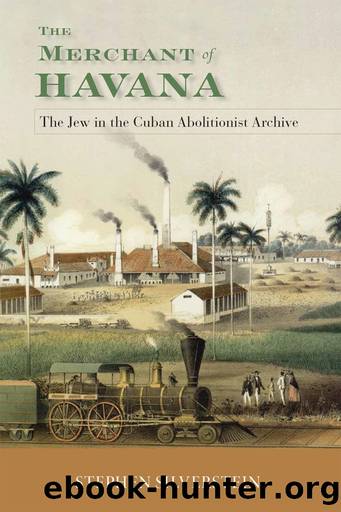The Merchant of Havana by Stephen Silverstein

Author:Stephen Silverstein [Silverstein, Stephen]
Language: eng
Format: epub
Tags: History, Caribbean & West Indies, Cuba, Religion, Religious Intolerance; Persecution & Conflict, Literary Criticism, Caribbean & Latin American
ISBN: 9780826503848
Google: R7wpEAAAQBAJ
Publisher: Vanderbilt University Press
Published: 2021-04-30T00:22:27+00:00
Notes
INTRODUCTION
1. John George F. Wurdemann, Notes on Cuba (Boston: James Munroe, 1844), 82. Although I remind the reader that race is a social invention, I do not italicize racial categories for the same reasons as those specified by Matthew Frye Jacobson in Whiteness of a Different Color: European Immigrants and the Alchemy of Race (Cambridge, MA: Harvard UP, 1998), ixâx.
2. Wurdemann, Notes, 166.
3. Esteban Pichardo y Tapia, Diccionario provincial casi razonado de vozes y frases cubanas (La Habana: Impr. El Trabajo, 1875), 216; âLa persona irreligiosa o desmoralizada, impÃa. El vulgo suele tambien llamar Judios por menosprecio a los Extrangeros.â It was Domingo Del Monteâs desire that a dictionary of Cuban provincialisms be produced, and Pichardo, in the words of Del Monte, âtook advantage of the idea, and published his respectable workâ (Domingo Del Monte, Centón epistolario, 4 vols. [La Habana: Imagen Contemporánea, 2002], 1: 208 n11); âaprovechó, entonces, la idea, y publicó su apreciable trabajo.â
4. Dale Tomich, Through the Prism of Slavery: Labor, Capital, and World Economy (Oxford: Rowman and Littlefield, 2004), 93; see also 133. Hugh Thomas describes Cubaâs entrance into the world economy in similar terms: âCuba was thus becoming dependent on the world market, not only in respect of sugar prices but also in respect of both capital and labourâ (Cuba; or, The Pursuit of Freedom [New York: Da Capo, 1998], 66; see also 73â74).
5. I am borrowing from Stuart Hallâs âRace, Articulation and Societies Structured in Dominance,â in Sociological Theories: Race and Colonialism (Paris: UNESCO, 1980), 305â45.
6. My conceptualization of anti-Semitism is fundamentally informed by Zygmunt Baumanâs Modernity and the Holocaust (Ithaca, NY: Cornell UP, 2000). This sentence is instructed by Baumanâs contention that âthe Jews were caught in the most ferocious of historical conflicts: that between the pre-modern world and advancing modernity. The conflict found its first expression in the overt resistance of the classes and strata of the ancien régime about to be uprooted, disinherited and ploughed out of their secure social locations by the new social order which they could not but perceive as a chaosâ (Modernity and the Holocaust, 45â46). Earlier he writes: âFor most members of society, the advent of modernity meant the destruction of order and security; and once again, the Jews were perceived as standing close to the centre of the destructive process. Their own rapid and incomprehensible social advancement and transformation seemed to epitomize the havoc visited by advancing modernity upon everything familiar, habitual and secureâ (Modernity and the Holocaust, 45).
Rosemary R. Ruether discusses these processes along similar lines:
The processes of emancipation coincided with traumatic changes in European society in the revolutionary era which dissolved the old Christian order for secular, liberal industrialized society. Thus the processes through which Jews entered mainstream society also created a traumatic reaction in those classesâclerics, landholders, and lower-middle-class artisansâwho were deeply threatened by the new secular industrial society. The secular Jews were hardly the creators of these new forces. [. . .] Yet they were concentrated in urban areas and in professions that made them highly conspicuous.
Download
This site does not store any files on its server. We only index and link to content provided by other sites. Please contact the content providers to delete copyright contents if any and email us, we'll remove relevant links or contents immediately.
The Power of Myth by Joseph Campbell & Bill Moyers(989)
Half Moon Bay by Jonathan Kellerman & Jesse Kellerman(941)
A Social History of the Media by Peter Burke & Peter Burke(926)
Inseparable by Emma Donoghue(910)
The Nets of Modernism: Henry James, Virginia Woolf, James Joyce, and Sigmund Freud by Maud Ellmann(819)
The Spike by Mark Humphries;(755)
The Complete Correspondence 1928-1940 by Theodor W. Adorno & Walter Benjamin(735)
A Theory of Narrative Drawing by Simon Grennan(734)
Culture by Terry Eagleton(698)
Ideology by Eagleton Terry;(687)
Bodies from the Library 3 by Tony Medawar(673)
World Philology by(668)
Farnsworth's Classical English Rhetoric by Ward Farnsworth(665)
Game of Thrones and Philosophy by William Irwin(660)
High Albania by M. Edith Durham(646)
Adam Smith by Jonathan Conlin(637)
A Reader’s Companion to J. D. Salinger’s The Catcher in the Rye by Peter Beidler(633)
Comic Genius: Portraits of Funny People by(609)
Monkey King by Wu Cheng'en(600)
